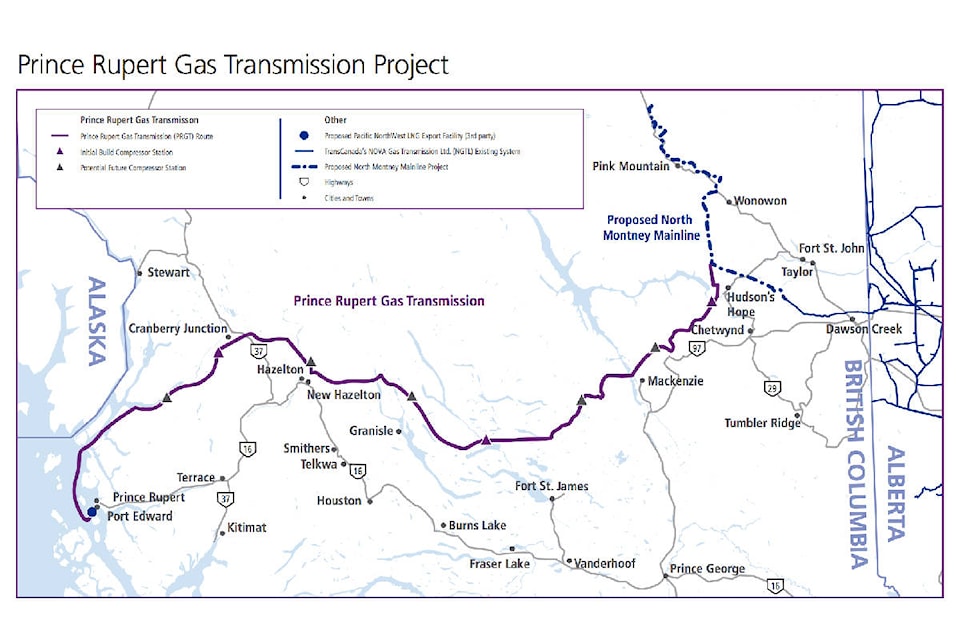A B.C. Supreme Court judge has dismissed a legal challenge from community and environmental groups opposed to a section of the Prince Rupert Gas Transmission pipeline, ruling they did not have the legal standing to bring the case.
The decision, issued Aug. 20 by Justice Michael Tammen, concerned a petition brought forward by the Skeena Watershed Conservation Coalition, Kispiox Valley Community Centre Association and the Kispiox Band against the British Columbia Energy Regulator, Prince Rupert Gas Transmission Ltd., and the Nisga’a Lisims Government.
The groups had asked the court to review a BC Energy Regulator (BCER) decision that cleared the way for construction to begin on Section 5B of the pipeline. They argued the regulator failed to enforce a permit condition requiring a cumulative effects assessment before construction could start.
Justice Tammen declined to weigh in on whether the regulator acted lawfully, instead ruling the groups lacked the legal standing to bring the matter forward.
“I have determined that I need not address the substantive challenge to the decision,” he wrote. “Rather, the petition must be dismissed because the petitioners lack standing to bring this application for judicial review.”
The PRGT project is a 900-kilometre natural gas pipeline proposed to run from Hudson’s Hope in northeastern B.C. to a liquefied natural gas facility on Nisga’a Lands near Pearse Island, about 82 kilometres north of Prince Rupert. The project was granted an Environmental Assessment Certificate (EAC) in 2014. Construction had not begun by the original 2019 deadline, and the EAC was extended to November 2024. The permit for Section 5 was first issued in 2015 and has since been renewed annually.
Section 5B spans roughly 77 kilometres entirely within Nisga’a Lands. The regulator deemed the cumulative effects condition satisfied based on information submitted earlier that year by PRGT. Justice Tammen noted Section 5B does not pass through the Kispiox or Skeena Valleys, where the petitioners are located.
In a statement issued through their legal counsel at Ecojustice, the petitioners said the ruling leaves unresolved their core concern: that the regulator failed to uphold its own conditions. They maintain the required cumulative effects assessment was not completed before construction began in August 2024, and that the regulator focused narrowly on Section 5B and the views of nearby residents rather than the broader industrial impacts of the full pipeline route.
Skeena Watershed Conservation Coalition co-executive director Shannon McPhail said the court sidestepped a critical public interest question.
“We had a question for the courts about whether or not the regulator adhered to its own permit conditions and B.C. legislation — that question remains unanswered as the judge determined that we did not have standing to even pose the question,” she said. “This should be a wake-up call for all British Columbians that our energy regulator is not looking after the public interest.”
To determine legal standing, the court applied a three-part test: whether the case raised a serious legal issue, whether the petitioners had a genuine interest in the matter, and whether the petition was a reasonable and effective way to bring the issue before the court.
Tammen found none of the three criteria were met, describing the petition as a challenge to a “micro-decision” related to one segment of a project that had already undergone a full environmental assessment.
“The thrust of the petitioners’ position is that, because of the passage of time, an updated cumulative effects assessment was necessary,” he wrote. “That submission hinges on the fact that the EAC was in the final year of its ten-year lifespan. That is undoubtedly so, but the more important fact is that the EAC had not yet expired and was still valid.”
The court also found the petitioners were not directly affected by the Section 5B decision. The Kispiox Band holds no rights or title over the section, and the Gitxsan Hereditary Chiefs—who do—had signed a project agreement with the proponent.
“The fact that each is a society committed to one side of an issue is not sufficient to create a genuine interest,” the ruling states.
While the third factor—whether the petition was a reasonable and effective way to bring the matter before the court—was described as “not straightforward,” the judge said the groups’ concerns were largely environmental and not specific to Section 5B.
“The petitioners’ perspective relates to the broader issues of climate change, cumulative effects of the entire project, and other concerns related to the environment,” he wrote, adding they may raise those concerns if and when a permitting decision is made for Section 5A, which crosses the Kispiox Valley and Skeena River watershed.
“Considered cumulatively, the three factors do not favour granting standing to the petitioners,” the ruling states. “To some extent, Skeena and Kispiox CCA appear to be ‘busybody’ litigants, seeking to challenge a micro-decision made in the course of a much larger project when that decision does not meaningfully affect them.”
The petition was dismissed in full. The court also ordered the petitioners to pay legal costs to PRGT and the Nisga’a Lisims Government. Justice Tammen noted both parties are private entities defending their economic interests.
“The petitioners sought to challenge on judicial review a decision that had no obvious impact on them or their direct interests. They did so based on their general opposition to the pipeline construction,” the decision reads.
Ecojustice lawyer Matt Hulse said the ruling limits who can hold regulators accountable.
“Impacts from the construction of a pipeline are not experienced section by section – the impacts from one section combine with the impacts of others,” he said. “Capturing the combined effects is the purpose of a cumulative effects assessment. Our clients will be impacted by the combined effects of pipeline construction upstream and downstream of them. That is why they brought this case, and it’s disappointing that the Court did not recognize this.”
The group has 30 days to decide whether to appeal.



